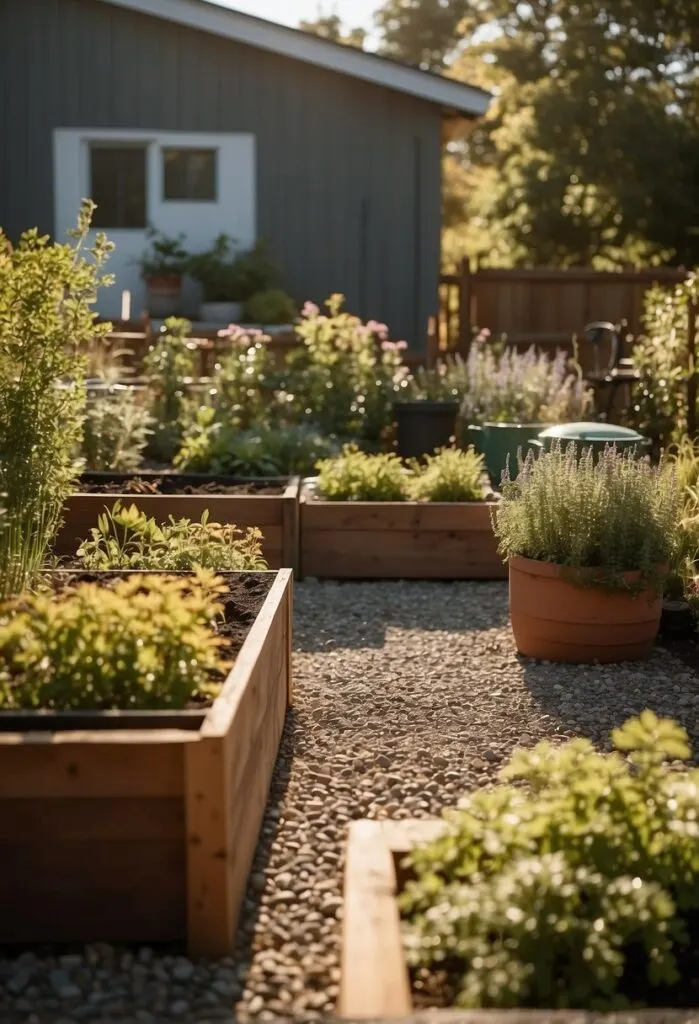If you have a muddy yard…and kids…and pets…you likely also have a muddy mess. Muddy spots in your yard can spread both across your yard and into your home, dooming you to a lifetime of keeping a towel at your back door. Or does it?!
Luckily for you, I’ve spent years battling a muddy lawn and as a result, have ideas for muddy backyard to last for daaaaays…and it all starts with assessing your muddy lawn.
Understanding Your Muddy Yard
Before you can effectively tackle the issue of a muddy area, it’s crucial to understand the composition of your soil and how excess water behaves in your outdoor space. This knowledge will offer a great way to determine the best solutions for your space.
While many believe they need a professional landscaper to conduct this assessment, you might just surprise yourself with the observations you can make on your own, especially after heavy rainfall!
Soil Analysis
Begin by identifying your soil type, as this will significantly influence how water interacts with your yard. For instance:
- Sandy Soil: This soil type dries quickly and doesn’t hold excess water well.
- Clay Soil: Known for its density, clay soil retains water, leading to wet soil conditions.
- Loamy Soil: Ideal for most gardens, loamy soil type has a good balance, allowing proper drainage and nutrient retention in wet soil.
You can perform a simple jar test at home to determine your soil type.
Fill a clear jar with soil and water, shake it, and let it settle. The layers will reveal whether your soil type is more sand, silt, or clay.
Water Flow Assessment
Monitor where excess water accumulates after heavy rainfall. Some key observations might include:
- Low spots where excess water collects, indicating poor drainage
- Slopes that direct water toward your home rather than away
- Areas that remain damp for extended periods after heavy rainfall
Analyze the way water flows across your yard. Look for patterns, and consider installing interventions such as drains or swales to redirect excess water flow.
This assessment of low spots and slopes is essential to ensure any modifications you make will effectively address the drainage issues.

Temporary Solution for Muddy Backyards
Experiencing muddy spots in your yard can be a huge pain, especially after heavy rainfall. Fortunately, there are quick and effective ways to address these mud patches temporarily until a more permanent solution can be implemented.
Wood Chips and Pea Gravel
Using wood chips is one of the most economical and best ways to cover a muddy area in your backyard. Not only do they absorb excess water, but they can also add a natural, aesthetic appeal to a small area or even a large area.
Simply spread a generous layer over the mud pit to create a temporary pathway or play area.
If you’re looking for something more substantial, pea gravel could be a great alternative. This small, smooth stone can provide excellent drainage, keeping your feet dry and low-lying areas mud-free.
Remember, this is a temporary solution that helps with surface-level mud but won’t solve underlying drainage issues caused by low spots and slopes in your backyard.
- Benefits of Wood Chips:
- Absorbent, reducing surface mud
- Cost-effective
- Enhances yard appearance
- Benefits of Pea Gravel:
- Improves drainage
- Durable and low-maintenance
- Adds a clean, finished look to your landscape
Landscape Fabrics
Another temporary solution to muddy backyards is the use of landscape fabric. This can act as a barrier to prevent weeds and also stabilize the soil.
Installing landscape fabric is straightforward:
- Clear the area of any debris and level out the muddy patches as much as you can.
- Lay the fabric over the muddy areas, securing it with garden staples.
Cover the fabric with mulch, wood chips, or pea gravel to enhance its effectiveness and improve the look of your yard. It’s one of the most inexpensive and best ways to handle muddy spots over a large area, and it can last for several seasons if maintained properly.
Remember, these fixes may not solve deeper drainage problems, so you might eventually need to explore a more long-term solution.

Long-Term Solution
When you’re ready to address your muddy areas once and for all, a more long-term solution is your best bet. These approaches not only manage the immediate problem but also avoid future potential for muddy messes.
Let’s explore a few permanent solution options you can consider.
Installing a French Drain
A French drain is a popular long-term solution for waterlogged yards. Essentially, it’s a gravel-filled trench with a perforated pipe that diverts excess water away from the problem area.
Installing a French drain requires some upfront work, but is a great way to significantly improve drainage over a large area, making it a permanent solution for soggy yards.
Retaining Walls and Terracing
Building retaining walls and incorporating terracing are some of the best ways to manage soil erosion and rain runoff – two common culprits of muddy yards. They work by creating physical barriers that level the ground and prevent soil from washing away.
These structures not only serve a functional purpose but can also enhance the aesthetics of your outdoor space. A retaining wall might just be the best option if your landscape is on a slope and you’re looking for a solution that is as visually appealing as it is practical.
While you can certainly build retaining walls on your own, consider enlisting a professional landscaper if you’re not feeling up to the task!
Planting Grass Seed
Once you’ve addressed drainage issues and built a retaining wall, you may want to consider planting grass seed to avoid muddy spots in the future. Here are some tips to help you succeed:
- Address Drainage Issues: Before planting, it’s crucial to resolve any drainage problems because excessive moisture can hinder grass growth and lead to more mud. Consider adding organic matter to improve the soil’s drainage and structure.
- Prepare the Soil: If the area is currently muddy, wait for it to dry out a bit before working on it. Once it’s manageable, level the ground and remove any debris. You can also add a thin layer of topsoil to provide a better seedbed.
- Choose the Right Seed: Select a grass seed that is suitable for your climate and soil type. Some grass types are more tolerant of wet conditions than others.
- Sow the Seeds: Spread the grass seed evenly across the prepared soil. Be careful not to bury the seeds too deeply. A general rule is to plant seeds at a depth of about two times their diameter.
- Light Topdressing: After seeding, you can apply a light topdressing, such as peat moss or compost, to help retain moisture and protect the seeds. However, it’s important not to apply this layer too thickly, as it can smother the seeds.
- Water Carefully: Water the seeded area gently to avoid washing away seeds or creating more mud. The goal is to keep the soil consistently moist but not waterlogged. Water the grass seed twice a day for about five to 10 minutes, and be cautious of standing water.
- Maintenance: Once the grass starts to grow, reduce watering frequency but increase the amount of water to encourage deeper root growth. Mow the lawn when the grass reaches an appropriate height for the species you’ve planted.
- Patience: Growing grass in a muddy area may take more time and attention. Be patient and adjust your care as the grass establishes itself.
By following these tips and consistently caring for the newly seeded area, you can transform a muddy mess into a lush, green lawn.
Landscaping Options to Consider
Your backyard’s muddy area can be transformed into an asset with thoughtful landscaping choices. There are loads of practical and aesthetic solutions to turn muddy messes around.
Creating a Rain Garden
A rain garden offers a beautiful and functional option to alleviate muddy areas.
By constructing a shallow depression in the landscape, you can plant it with species that thrive in wet soil conditions and effectively handle stormwater runoff. This not only reduces mud but also enhances your yard’s ecology.
For the best results, place your rain garden at least 10 feet away from your home to prevent any water-related issues. (Better a muddy yard than a flooded house!)
Consider hiring a professional landscaper if you’re unsure about the specifics of grading and soil selection for your rain garden.
Selecting Ground Cover and Creeper Plants
Opting for ground cover plants or creeper plants can provide an attractive and low-maintenance solution to muddy areas in your yard. Creeper plants like ivy or periwinkle make excellent choices, as their plant roots stabilize the soil and prevent soil erosion.
When selecting your ground cover, focus on varieties that will thrive in your region and soil type, ensuring a lush and durable lawn alternative. Ground cover plants can be aesthetically pleasing and practical, offering a year-round green vista.
Consider adding mulch or wood chips in the initial stages to protect ground cover plant roots while they establish.

Enhancing Usability and Aesthetics
Creating a functional and beautiful outdoor space involves tackling your muddy area while also considering design. You can transform your backyard from muddy patches into a well-structured escape where practicality meets visual appeal.
Paths and Walkways
Building paths and walkways is one of the best ways to navigate your yard without fighting your way through a mud pit. Consider using materials like pea gravel or wood chips to construct paths that are usable in any weather.
A walking path is not only a practical solution for maneuverability but can also serve as a design element over a large area, leading the eyes and feet through your garden. For instance, creating a winding path that passes through your flower beds can enhance both the usability and the aesthetics of your entire backyard.
It’s a good idea to lay stepping stones or cement pavers with aggregates like pebbles or bark mulch in between for a natural look. Some of the best ways to lay out your walking path:
- Stepping Stones/Cement Pavers: Regular intervals for a consistent pathway
- Pebbles/Bark Mulch: Fill the gaps for improved drainage and visual appeal
Outdoor Features and Zen Gardens
Incorporating outdoor features and Zen gardens is a great way to turn a muddy lawn into a serene retreat. With a focus on simplicity and tranquility, a Zen garden can offer a contemplative space in your backyard that’s both soothing and practical.
A Zen garden emphasizes the balance between natural and designed elements. Add raked sand or pea gravel framed with decorative rocks to symbolize water, complemented by selective plantings like Irish moss or small shrubs.
Here’s how you could structure a Zen garden:
- Raked Sand/Pea Gravel: Represents water, providing a calm texture
- Decorative Rocks and Boulders: Serve as focal points and structural elements
- Plants: Choose species like bamboo or ferns for a touch of green
By incorporating these features into your entire backyard, you’re not just fixing a muddy pit…you’re enhancing your outdoor living experience!

And there you have it…temporary and long-term solutions to turn your muddy areas into a backyard oasis!
Did we miss any ideas for muddy backyard that you swear by? Be sure to share in the comments!

P.S. Need some easy dinner ideas while you work on your yard? We’ve got you covered! Download our free ebook of 40 stupid easy recipes that will save you MAJOR time and effort, while keeping your family happy! Get yours HERE.
Disclosure: While all opinions are our own, we are a participant in the Amazon Services LLC Associates Program and other affiliate advertising programs, designed to provide a means for us to earn fees by linking to Amazon.com and affiliated sites, at no additional cost to you.



